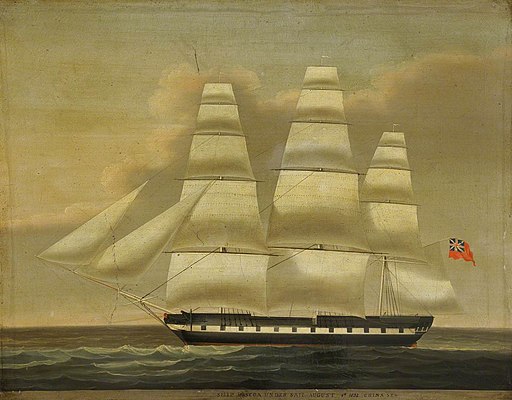The borrowed description of teak wood as "the King of the Oaks" in Chapter 34 of Herman Melville's Redburn indicates that by summer 1849 at the latest, Melville already owned or had access to a copy of the Narrative of Voyages and Travels by Amasa Delano. Melville got the purportedly oriental phrase "king of the oaks" from Delano's description of Bombay in chapter 12. Six years later, Melville would remake chapter 18 of Delano's Narrative into the 1855 thriller, Benito Cereno.
Arrived in Liverpool, Melville's narrator Wellingborough Redburn visits a large merchant ship from Bombay named the Irrawaddy.
AMONG the various ships lying in Prince's Dock, none interested me more than the Irrawaddy, of Bombay, a "country ship," which is the name bestowed by Europeans upon the large native vessels of India. Forty years ago, these merchantmen were nearly the largest in the world ; and they still exceed the generality. They are built of the celebrated teak wood, the oak of the East, or in Eastern phrase, "the King of the Oaks." -- Redburn Chapter 34 - The Irrawaddy
For the factual substance of the Irrawaddy chapter, Melville creatively plagiarized from the Penny Cyclopaedia entry for Tectona, as Willard Thorp first discovered.
Thorp's findings are summarized by Hershel Parker in the Historical Note for the 1969 Northwestern-Newberry edition of Redburn. Mary K. Bercaw documents additional borrowings from the Penny Cyclopaedia in Redburn and other novels in "The Infusion of Useful Knowledge: Melville and The Penny Cyclopaedia," Melville Society Extracts 70 (September 1987) pages 9-13.
TECTONA in the Penny Cyclopaedia supplied Melville's phrase "oak of the East"
https://books.google.com/books?id=GxwDAAAAYAAJ&pg=RA3-PA141&dq#v=onepage&q&f=false
but besides the narrator of Redburn, only Amasa Delano calls teak wood "the king of the oaks."
 |
| Amasa Delano, Narrative of Voyages and Travels (Boston, 1817) page 213. |
The people of Bombay have many large ships of their own. The largest merchant ships in the world are built there, and belong to the commercial capitalists of the town. The ship builders are all natives, and are pre-eminent in their profession. They build many ships of the teak wood, which they call the king of the oaks, and which they procure from Pegu. It is as large as our largest oaks, the timber very straight, free from knots, and excellent for planks. I have seen it grow fifty feet before a limb shoots from the trunk. Some of them are three feet in diameter. There is another kind of tree, which is called there sissor-wood, and which is the best in the world for the crooked timber required in ships. It is extremely hard and durable. -- Amasa Delano, Narrative of Voyages and Travels (Boston, 1817).
https://books.google.com/books?id=34QqAQAAIAAJ&pg=PA213&dq#v=onepage&q&f=false
Like Delano, Melville's narrator emphasizes the size of merchant ships built in India:
"these merchantmen were nearly the largest in the world" - REDBURN
"... largest merchant ships in the world" - DELANO
Delano also names Pegu as the place for getting teak...
"I thought I was in Pegu, so strangely woody was the smell of the dark-colored timbers...." (REDBURN)
"... which they procure from Pegu." (DELANO)
But Redburn's sensory experience of the "woody" odor seems, like the name of the Bombay vessel, to have been inspired by the "forests"
of teak "along the banks of the Irrawady, especially in Pegu" as described in the Penny Cyclopaedia entry TECTONA. Same goes for the expression "oak of the east," also found in TECTONA, the Penny Cyclopaedia entry first identified by Willard Thorp as Melville's source for the Irrawaddy chapter in Redburn. Not "King of the Oaks" though. Searches on Google Books and HathiTrust Digital Library yield only two works containing the phrase "the king of the oaks" before 1850: Delano's Narrative and Melville's Redburn. In old British newspapers, teak as "king of the oaks" appears only in excerpts from Redburn Chapter 34, sometimes (as in the London Guardian for November 2, 1850 and Liverpool Mercury on November 5, 1850) headed
A BOMBAY "COUNTRY SHIP."

Delano's Narrative is Number 200 in Mary K. Bercaw's 1987 checklist of Melville's Sources. In previous Melville scholarship, possible literary debts to Delano outside of Benito Cereno have been identified in White-Jacket (1850) and The Encantadas (1854). And, more questionably, in Typee (1846). Hershel Parker speculates in the second volume of Herman Melville: A Biography (Johns Hopkins University Press, 2002) that Melville might have encountered Captain Amasa Delano's Narrative by 1847, in time for use in Mardi (1849). Listed as "Delano's Voyages and Travels" in the 1828 Catalogue of Books in the Albany Library, page 23
and so indexed in the 1838 and 1850 Catalogue of the New York Society Library.
With further study, more traces of Melville's reading in Delano's Narrative may turn up in Redburn and elsewhere in Melville's published writings.
Further reading:
- Anne Bulley, The Bombay Country Ships 1790-1833
https://books.google.com/books/about/The_Bombay_Country_Ships_1790_1833.html?id=qVxcAgAAQBAJ
- Lascar Sailors - The Maritime History Page
http://www.pandosnco.co.uk/lascars-two.htm
- Aaron Jaffer, Lascars and Indian Ocean Seafaring, 1780-1860
https://boydellandbrewer.com/9781783270385/lascars-and-indian-ocean-seafaring-1780-1860/
Related post:
- The Picture of Liverpool - Melville's Prosy Old Guidebook
https://melvilliana.blogspot.com/2015/12/the-picture-of-liverpool-redburns-prosy.html




No comments:
Post a Comment